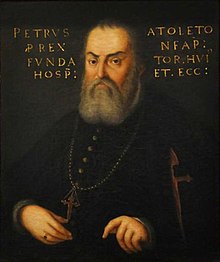Pedro Álvarez de Toledo, 2nd Marquis of Villafranca
|
Pedro Álvarez de Toledo Marquis of Villafranca del Bierzo |
|
|---|---|
 |
|
| Viceroy of Naples | |
|
In office September 1532 – 1552 |
|
| Monarch | Charles V |
| Preceded by | Pompeo Cardinal Colonna |
| Succeeded by | Luis Álvarez de Toledo y Osorio |
| Personal details | |
| Born |
July 13, 1484 Madrid, Spain |
| Died | February 21, 1553 (aged 68) Florence, Italy |
| Spouse(s) | Maria Osorio, 2nd Marquise of Villafranca del Bierzo |
| Religion | Catholic |
Pedro Álvarez de Toledo y Zúñiga, jure uxoris Marquis of Villafranca del Bierzo (Spanish: Pedro Álvarez de Toledo y Zúñiga, Marqués de Villafranca del Bierzo; July 13, 1484 – February 21, 1553) was a Spanish politician. The first effective Spanish viceroy of Naples, in 1532–1552, he was responsible for considerable social, economic and urban change in the city and southern Italian kingdom, in general.
He was born in 1484 near Salamanca in Spain, the second son of Fadrique Álvarez de Toledo, 2nd Duke of Alba. His paternal grandmother was Maria Enriquez, the sister of Juana Enríquez, Queen Consort of Aragon through her marriage to widower king of Aragon Juan II of Aragon, and the mother of Ferdinand II of Aragon and ancestress of Habsburgs. Through this relation, Charles V, Holy Roman Emperor and King of Spain was a second cousin of Don Pedro.
Spain took over the Kingdom of Naples in 1503 and solidified her grasp after the final, failed attempt by France in 1529 to retake the kingdom. For the first three decades of the century, a succession of inconsequential viceroys ruled the vicerealm. Don Pedro arrived as viceroy in September 1532.
Don Pedro’s rebuilding of the city went on for years. Old city walls were expanded and an entirely new wall was built along the sea front. Fortresses along those walls and further up and down the coast from the city were modernized, and the Arsenale—the naval shipyards—were expanded considerably. Don Pedro also built the viceregal palace as well as a dozen blocks of barracks nearby, a square grid of streets lined with multi-storied buildings—unique in Europe for its time. Today, that section of Naples is still called the “Spanish Quarter”. The goal was to make not just the city of Naples, but the Gulf of Naples and eventually, the entire vice-realm invulnerable—that is, the entire southern Italian peninsula.
...
Wikipedia
